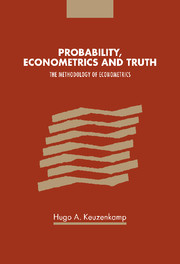Book contents
- Frontmatter
- Contents
- Introduction
- 1 The philosophy of induction
- 2 Probability and indifference
- Intermezzo: a formal scheme of reference
- 3 Relative frequency and induction
- 4 Probability and belief
- 5 The theory of simplicity
- 6 From probability to econometrics
- 7 Econometric modelling
- 8 In search of homogeneity
- 9 Positivism and the aims of econometrics
- 10 Probability, econometrics and truth
- Personalia
- References
- Name Index
- Subject Index
6 - From probability to econometrics
Published online by Cambridge University Press: 22 September 2009
- Frontmatter
- Contents
- Introduction
- 1 The philosophy of induction
- 2 Probability and indifference
- Intermezzo: a formal scheme of reference
- 3 Relative frequency and induction
- 4 Probability and belief
- 5 The theory of simplicity
- 6 From probability to econometrics
- 7 Econometric modelling
- 8 In search of homogeneity
- 9 Positivism and the aims of econometrics
- 10 Probability, econometrics and truth
- Personalia
- References
- Name Index
- Subject Index
Summary
It is a curious fact, which I shall endeavour to explain, that in this case a false hypothesis, which is undoubtedly a very convenient one to work upon, yields true results.
Francis Galton (cited in Stigler, 1986, p. 274)Introduction
What can we infer about a universe from a given sample? This is the recurring question of probabilistic inference. Bowley ([1901] 1937, p. 409), answers that the only bridge is the Bayesian one. In a footnote, he makes the distinction between the problem ‘given the target how will shots be dispersed?’ and ‘given the shot-marks, what was the target?’ The first question can be answered by means of Fisher's analysis of variance, the second ‘is the practical question in many cases when we have only one sample’ and necessarily depends on Bayesian inference (p. 409).
But the Bayesian argument never gained a strong foothold in econometrics: the frequency theory prevailed. The link between probability theory and practical statistics is sampling theory, which should provide the justification for using (parametric) regression techniques of inference. But econometrics uses sampling theory more in a rhetorical than in the real sense. This chapter discusses the limitations of sampling theory in econometrics.
This chapter deals with how the different elements of probability filtered into econometrics. Section 2 briefly reconsiders the key elements of sampling theory. Section 3 is about regression. The contributions of Galton and Yule are discussed, including Galton's fallacy and ‘nonsense correlation’.
Information
- Type
- Chapter
- Information
- Probability, Econometrics and TruthThe Methodology of Econometrics, pp. 119 - 141Publisher: Cambridge University PressPrint publication year: 2000
